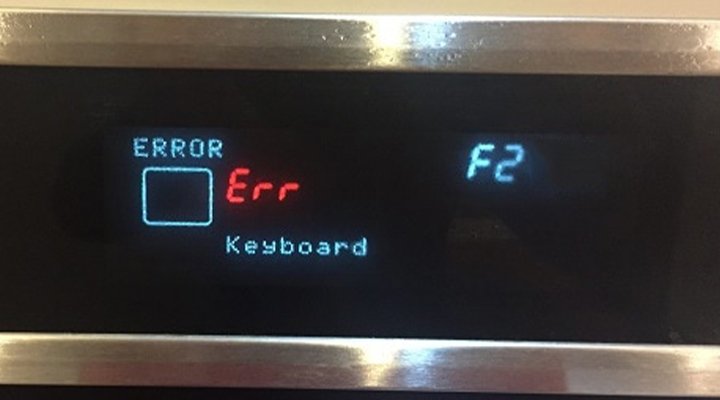
You might be wondering if this code is a sign of something catastrophic. Don’t worry; it’s not the end of the world. Essentially, the F2 error code means that your oven has detected a temperature problem. Think of it as your oven’s way of waving a red flag, saying, “Hey, something’s not right here!” Whether it’s running hotter than usual or there’s an issue with the internal temperature sensor, it’s important to tackle this problem so your culinary adventures can continue without a hitch.
Understanding the F2 Error Code
So what exactly is the F2 error code trying to tell you? In simple terms, it’s all about temperature control. Your oven has a built-in thermometer, known as a temperature sensor, that keeps track of how hot things are getting inside. If something goes awry—perhaps the oven gets too hot or the sensor isn’t reporting the correct temperature—the F2 code pops up to let you know there’s an issue.
Imagine the temperature sensor as the thermostat in your home. Just as your home’s thermostat tells you if it’s too warm or too cold inside, the oven’s temperature sensor does the same for its internal environment. If sensor readings suggest the oven is overheating, the F2 error alerts you to prevent potential damage or safety hazards. This might seem technical, but don’t worry—we’ll break down what might cause this and how you can address it.
Understanding that the F2 code is a safeguard can be reassuring. It’s your oven’s way of preventing bigger problems, kind of like how your car’s check engine light warns you before a breakdown. By addressing the issue, you ensure both the safety and efficiency of your appliance. So, let’s look at some common causes and simple solutions.
Common Causes of the F2 Error Code
Now that we know F2 is all about temperature issues, let’s dive into what might be causing these problems. A frequent culprit is a malfunctioning temperature sensor. If this sensor is faulty or misaligned, it might send incorrect readings to the oven’s control board, triggering the F2 error. Imagine trying to drive a car using a faulty speedometer—it could tell you you’re going 50 mph when you’re actually speeding at 80!
Another possibility is an issue with the oven’s control board itself. This is like the brain of your oven, processing information and telling it what to do. If this component is acting up, it might misinterpret the sensor’s signals, causing the code to appear. It’s as if your oven’s brain is having a little short-circuit moment, leading to incorrect conclusions about the oven’s condition.
Sometimes, the problem could simply be the oven is genuinely overheating. This might be due to using the oven at higher temperatures for extended periods, like when baking multiple batches of cookies back-to-back. In such cases, letting your oven cool down before resuming use could resolve the issue. As you see, understanding these potential causes brings you closer to a solution—much like unraveling the steps in a complicated recipe.
Steps to Fix the F2 Error Code
So you’ve seen the F2 code flashing, and now you’re ready to tackle it head-on. The first step is to check the oven’s temperature sensor. This component is often straightforward to replace if faulty. To do this, you’ll want to access the back of your oven (make sure it’s unplugged!) and locate the sensor, usually secured with just a couple of screws. If you’re unsure, consulting your oven’s manual can give you a clearer picture.
Another step is to evaluate the control board. This might seem daunting, but it’s often just a matter of checking connections and the condition of the board itself. Should you spot any obvious damage, like burn marks, replacing the board could be your best bet. It’s like swapping out a faulty battery in a remote—you need a working brain for optimal performance.
If these steps seem overwhelming, remember there’s no shame in calling a professional. Sometimes, a trained technician’s expertise is the quickest path to a solution, especially if the issue lies deeper within the oven’s components. And hey, after all, you’ve got meals to prep, and time’s ticking!
Preventing Future F2 Errors
Once you’ve tackled the F2 error, it’s natural to want to prevent it from happening again. Ensuring your oven’s temperature sensor is correctly aligned and cleaned can make a world of difference. Dust and grime can affect how the sensor reads temperatures, much like how smudges can obscure your glasses, leading to less-than-clear vision.
Moreover, avoid using extreme temperatures regularly. While high-heat baking is sometimes necessary, letting your oven cool between uses can prevent overheating. Think of it as giving your car’s engine a rest after a long drive—it helps maintain performance and longevity.
Lastly, performing periodic maintenance checks can keep your oven in top shape. By doing small things like checking wires and ensuring no blockages around air vents, you reduce the chances of malfunction. It’s like routine doctor visits to catch and address any health issues before they become serious.
In conclusion, the F2 error code doesn’t need to spell disaster. By understanding its causes, taking proactive steps to fix it, and applying preventive measures, you can ensure your Whirlpool oven serves you well in the kitchen. So next time you see that code flashing, you’ll know just what to do!